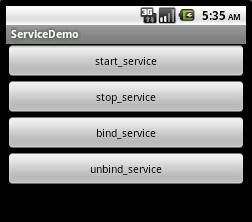android有四大组件,Activity,Broadcast Receiver,Service,Content Providers;
今天我先介绍下Service,Service功能和Activity类似(这个会在后续的文章中详细说明),Service可以说是一个没有试视图的Activity,就是隐藏的activity。
下面是官网给出的:
A Service is an application component representing either an application's desire to perform a longer-running operation while not interacting with the user or to supply functionality for other applications to use. Each service class must have a corresponding
<service> declaration in its package's AndroidManifest.xml. Services can be started with Context.startService() and Context.bindService().
Note that services, like other application objects, run in the main thread of their hosting process. This means that, if your service is going to do any CPU intensive (such as MP3 playback) or blocking (such as networking) operations, it should spawn its own
thread in which to do that work. More information on this can be found in Processes and Threads. The IntentService class is available as a standard implementation of Service that has its own thread where it schedules its work to be done.
(大概的意思:作为组建之一的Service,他代表是一个应用需要一个比较长时间的操作且用户不交互,或者给另外一个应用使用。而每个service都需要在AndroidManifest.xml中注册。service通过 Context.startService()和 Context.bindService()启动。
注意事项:
Service是在主线程中运行的,这就意味着,如果service做与cpu交互频繁(CPU高负荷的操作)或者阻塞的操作,这是就需要在新建一个自己的线程来做这些工作。IntentService继承于service,拥有自己的线程,在线程处理香醋要的事情。)
)
service的两种模式(startService()/bindService()不是完全分离的)
(1)本地服务Local Service 用于应用程序内部。
它可以启动并运行,直至有人停止了它或它自己停止。在这种方式下,它以调用Context.startService()启动,而以调用Context.stopService()结束。它可以调用Service.stopSelf() 或 Service.stopSelfResult()来自己停止。不论调用了多少次startService()方法,你只需要调用一次stopService()来停止服务。用于实现应用程序自己的一些耗时任务,比如查询升级信息,并不占用应用程序比如Activity所属线程,而是单开线程后台执行,这样用户体验比较好。
(2)远程服务Remote Service 用于android系统内部的应用程序之间。
它可以通过自己定义并暴露出来的接口进行程序操作。客户端建立一个到服务对象的连接,并通过那个连接来调用服务。连接以调用Context.bindService()方法建立,以调用 Context.unbindService()关闭。多个客户端可以绑定至同一个服务。如果服务此时还没有加载,bindService()会先加载它。
可被其他应用程序复用,比如天气预报服务,其他应用程序不需要再写这样的服务,调用已有的即可。
下面会介绍下关于service的内容:
service的生命周期;
Lcoal Service;
RemoteService;
先介绍生命周期(LifeCircile)
系统有两种启动Service的方法。如果调用Context.startService(),那么系统将会得到这个Service(如果必要则创建它并调用它的onCreate()方法),然后使用客户端传递的参数调用它的onStartCommand(Intent,int)方法。Service开始运行直到Context.stopService()或者stopSelf()方法被调用。注意,多次调用Context.startservice()不会嵌套(即oncreate只会被调用一次(service只会被创建一次,如果已经创建则不创建)这时会有相应的onStart()方法被调用),所以无论同一个服务被启动了多少次,一旦调用Context.stopService()或者stopSelf(),他都会被停止。
客户端也可以使用context.bindservice()来得到一个Service的永久链接。这个方法也会在服务没有运行的条件下创建服务(调用onCreate()),但是不调用onStart()。客户端会得到服务的onBind(Intent)方法返回的IBinder对象,用来允许客户端回调服务的方法。只要连接已经建立服务会一直运行下去(无论客户端是否保留服务的IBinder对象的引用)。通常返回的IBinder对象是AIDL中定义的复杂接口。
service还可以在启动的情况下绑定,或者绑定的情况下启动;
简单总结下:
1.通过startservice启动,onCreate->onStartCommand->onStart,(如果service已经创建过了,则就不会在调用onCreate);
2.通过调用onDestroy->stopService,停止service;(调用者自己直接退出,没有调用stopService,那么service一直会在后台运行)
3.通过bindservice启动,只调用onCreate,这个时候会绑定serviceDemo和service;
4.通过调用调用onUnbind->onDestroy,如果与activity绑定,则与activity共存亡;
5 . 混合启动:
/**
* 1.无论绑定和创建service,service只会被创建一次(就是oncreate只会被调用一次)
* 2.如果已经start,则可以bind
* 3.如果已经bind,则可以start
* 4.如果已经start,且bind,则不能使用stopservice,只能用unbind,然后在调用onstop(这个不会调用)
* 5.如果已经bind,且start,则stopservice不起作用,只能用unbind,然后在调用onstop(这个不会调用)
*/
6.启动service,根据onStartCommand的返回值不同,有两个附加的模式:
a. START_STICKY 用于显示启动和停止service。
b. START_NOT_STICKY或START_REDELIVER_INTENT用于有命令需要处理时才运行的模式。
拥有service的进程具有较高的优先级
官方文档告诉我们,Android系统会尽量保持拥有service的进程运行,只要在该service已经被启动(start)或者客户端连接(bindService)到它。当内存不足时,需要保持,拥有service的进程具有较高的优先级。
1. 如果service正在调用onCreate,onStartCommand或者onDestory方法,那么用于当前service的进程则变为前台进程以避免被killed。
2. 如果当前service已经被启动(start),拥有它的进程则比那些用户可见的进程优先级低一些,但是比那些不可见的进程更重要,这就意味着service一般不会被killed.
3. 如果客户端已经连接到service (bindService),那么拥有Service的进程则拥有最高的优先级,可以认为service是可见的。
4. 如果service可以使用startForeground(int, Notification)方法来将service设置为前台状态,那么系统就认为是对用户可见的,并不会在内存不足时killed。
如果有其他的应用组件作为Service,Activity等运行在相同的进程中,那么将会增加该进程的重要性。


这是本地service启动和绑定
上代码:
PotatoService.java
ServiceDemoActivity.java
在androidMainfest.xml中加上一下代码(注册service)
main.xml
最后给上官网上提供的lifeservice的辅助图一张,帮助理解:

By implementing these methods, you can monitor two nested loops of the service's lifecycle:
The entire lifetime of a service happens between the time onCreate() is called and the time onDestroy() returns. Like an activity, a service does its initial setup in onCreate() and releases all remaining resources in onDestroy(). For example,
a music playback service could create the thread where the music will be played in onCreate(), then stop the thread in onDestroy().
The onCreate() and onDestroy() methods are called for all services, whether they're created by startService() or bindService().
The active lifetime of a service begins with a call to either onStartCommand() or onBind(). Each method is handed the Intent that was passed to either startService() or bindService(), respectively.
If the service is started, the active lifetime ends the same time that the entire lifetime ends (the service is still active even after onStartCommand() returns). If the service is bound, the active lifetime ends when onUnbind() returns.If the service is started,
the active lifetime ends the same time that the entire lifetime ends (the service is still active even after onStartCommand() returns). If the service is bound, the active lifetime ends when onUnbind() returns.
Note: Although a started service is stopped by a call to either stopSelf() or stopService(), there is not a respective callback for the service (there's no onStop() callback). So, unless the service is bound to a client, the system destroys it when the service
is stopped—onDestroy() is the only callback received.
Figure 2 illustrates the typical callback methods for a service. Although the figure separates services that are created by startService() from those created by bindService(), keep in mind that any service, no matter how it's started, can potentially allow
clients to bind to it. So, a service that was initially started with onStartCommand() (by a client calling startService()) can still receive a call to onBind() (when a client calls bindService()).
有问题请留言
或者发邮件ligexiao@gmial.com
源码下载地址:
http://download.csdn.net/detail/alex0203/3834762
分享到:












相关推荐
Android四大组件简述demo用例。
Android 四大组件之Service的Demo
android四大组件详细介绍,activity,service等从基础到应用开发,熟练的掌握android 组件的应用。
android service 四大组件 完整代码 非常好用 非常经典 完整的代码.
这是一个介绍android四大组件中Service的ppt文档,里面阐述了该组件的基本应用,非常有价值。
service的启动,停止,绑定,取消绑定,以及IntentService的生命周期走向测试和IntentService与访问者信息通信过程,不清楚之处请参阅我的博客《Android开发四大组件之Service总结》
文档主要是讲Android开发的四大组件详解,包含 Activity详解 ,Service详解,Broadcast Receiver详解,Content Provider详解 外加一个重要组件 intent的详解。 文章内容来自网络,本文是一个总结性文章。
Android四大基本组件介绍与生命周期Android四大基本组件分别是Activity,Service服务,ContentProvider内容提供者,BroadcastReceiver广播接收器。 Android四大基本组件介绍与生命周期 Android四大基本组件分别是...
Android四大基本组件分别是Activity,Service服务,Content Provider内容提供者,BroadcastReceiver广播接收器。
简要解释一下activity、 intent 、intent filter、service、Broadcast、BroadcaseReceiver
根据博客内容,写的一个android 服务实例程序
Android四大基本组件介绍与生命周期 Android四大基本组件分别是Activity,Service服务,Content Provider内容提供者,BroadcastReceiver广播接收器......
Android四大组件之ServiceService的生命周期被启动(startService)的服务的生命周期:被绑定(bindService)的服务的生命周期:被启动又被绑定的服务的生命周期:实例布局创建Service类启动ServiceDemo下载 android开发...
博文android基础知识05:四大组件之service 02:远程调用中关于远程调用service的实例程序
android service的实例程序,用于博文http://blog.csdn.net/xianming01/article/details/7341877
Android四大组件——Service后台服务、前台服务、IntentService、跨进程服务、无障碍服务、系统服务
Android安全开发基础--3--四大组件之服务 (Service).pdf Android安全开发基础--4--四大组件之广播(Broadcast Receiver).pdf Android安全开发基础--5--四大组件之内容提供器(Content Provider).pdf Android安全...
服务常常被用来在后台悄悄的执行一些事情,这些事情是用户在不影响用户使用的情况下完成的,比如后台更新天气,下载文件等等,这个也是几乎每一款app产品都有的功能,这里是一个简单的服务demo
4.1.4 Android系统的四大组件 - 22 - 4.2 搭建Android开发环境 - 23 - 4.3 Android常用工具的使用 - 25 - 4.3.1 命令行的使用 - 25 - 4.3.2 Dalvik Debug Monitor Service (DDMS)的使用 - 26 - 4.4 Android 音乐...